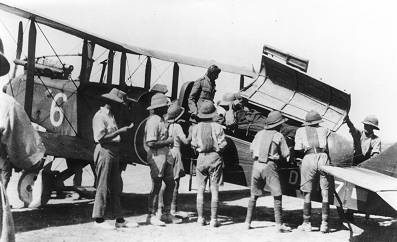
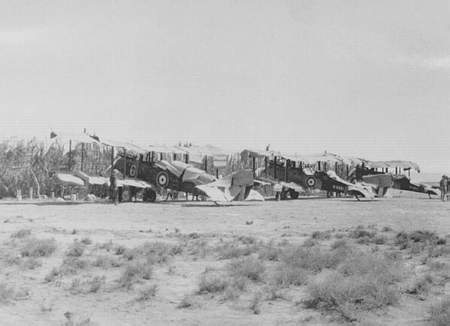
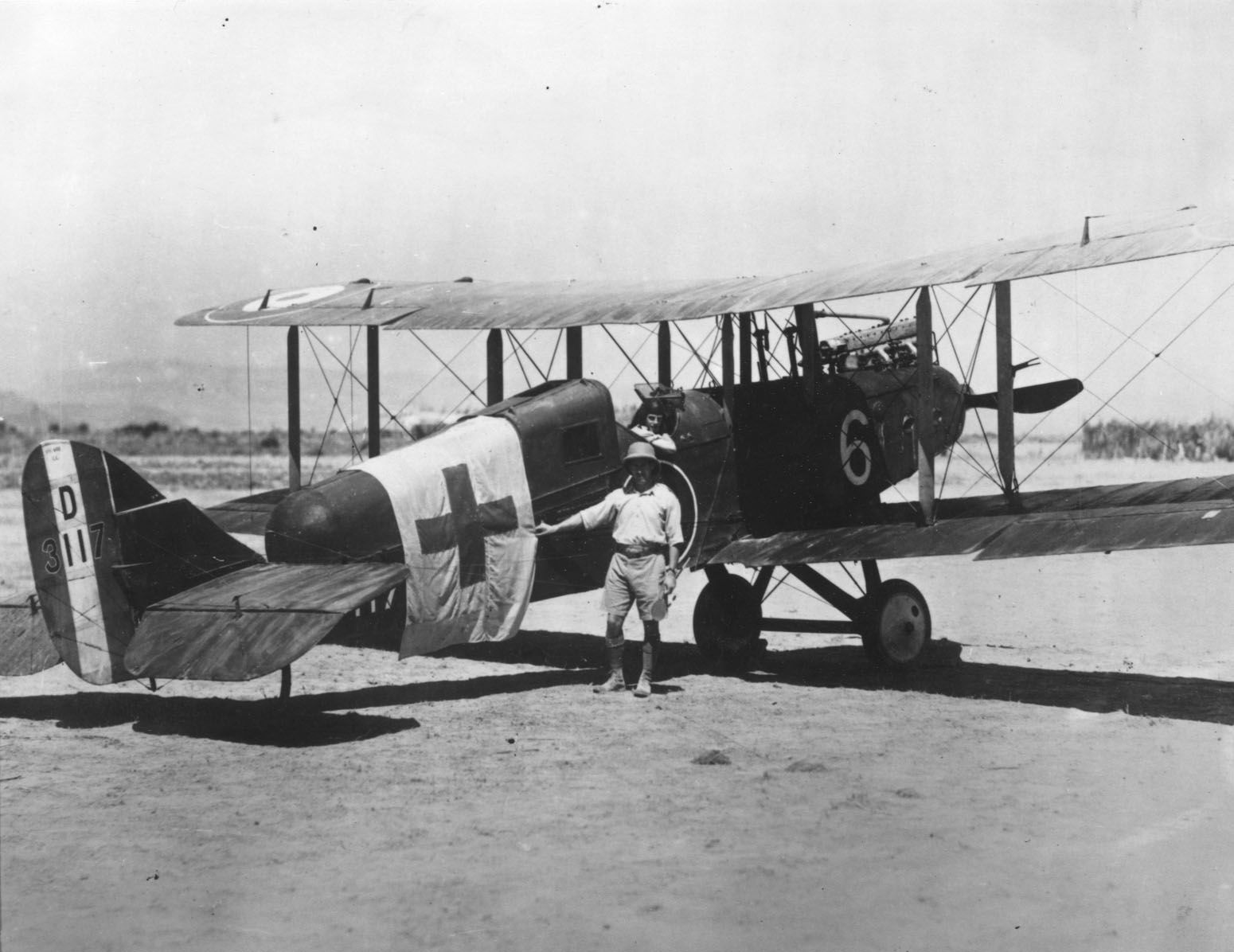
British Operations Against The mad mullah
A wargamer's Guide
The Air Operations 1919 - 1920
Given the impressive achievements of the Fifth Expedition it is worth looking in
some more detail at the Air Operations that I have not included in the main
text.
The ground locations were selected with great care for future
operations. Originally the main
base was to be sited at Las Khorai but this was found to be unsuitable because
of the difficulties of landing stores over the beach and the monsoon wind which
blew for 6 hours a day raising a sandstorm to an altitude of 200 feet.
It was, however, suitable as an Emergency Landing site.
Stocks of petrol and oil were positioned there.
The main base was moved to Eil Dur Elan where a suitable site was found
half a mile from a running water supply.
HMS Ark Royal was loaned by the Royal Navy for the deployment and this proved to
be of great value as it allowed the whole contingent of aircraft, stores and
motor vehicles to be delivered at once.
Unloading the crated aircraft at Berbera was considerably facilitated by
the use of a lighter with an improvised deck. The harbour facilities there were
quite primitive. The assembly of
the aircraft started on 1 January 1920.
It took a week to get the first three DH-9A aircraft into a flying
condition and the others constructed awaiting flight testing.
 |
 |
 |
| DH 9A Ambulance open | DH 9A Bombers of Force Z | DH 9A Ambulance |
The DH-9A bombers were not the only part of the air component. At least two DH-9A air ambulances were brought in to carry out aero-medical evacuation.
The British use of aircraft came as a complete surprise to
the Dervishes. The bombing raids on
the forts caused heavy casualties amongst the Dervish followers and their
livestock. They also attacked the
brushwood huts that were scattered around the forts and many were set on fire.
In addition to bombing from 800 feet,
the aircraft came down to 300 feet to strafe the Dervishes and this proved
particularly effective in both terms of inflicting material damage, casualties
and reducing morale. These
operations lasted from 21-23 January and a reconnaissance on 24 January showed a
cleared area nearly 30 miles radius around the forts.
From this it was deduced that the Mullah had already started to move his
followers and the Haroun southwards.
The semi-independent air operations were now halted in favour of close
support to the Somaliland Field Force.
The first of these combined operations took place between 25
and 30 January. They consisted of
intercommunication between the Somaliland Camel Corps, with 1˝ companies of the
101st Grenadiers, operating eastwards from El Afweina and the
Somaliland Camel Corps units advancing westwards from Musa Aled.
The aircraft carried out reconnaissance, reported positions and progress,
dropped messages and carried despatches between the units and the headquarters.
This service provided fast communication and enabled co-ordination to
level that had been impossible before.
Once Baran was captured by the Kings African Rifles an advanced landing
ground was prepared there. As the
campaign progressed over the next few days aeroplanes established contact with
the “friendlies” giving a degree of co-operation and communication that had
always bedevilled previous operations.
The demoralisation caused amongst the Dervishes by the
bombing attacks is very apparent when the assault on the fort at Baran by the
KAR and the flight of the Dervishes from Medishe and Jidali after they had been
bombed. At Baran, the fort had to
be surrounded, bombarded and then attacked.
It did not fall until the last defender was killed.
Medishe and Jidali were much stronger forts and were abandoned almost
immediately after the bombing raids.
The panic caused is exemplified by the number of rifles left behind by
the Dervishes. This was completely
unknown in previous campaigns.
Taleh also fell comparatively easily even though it was the most powerful of the
Dervish fortresses.
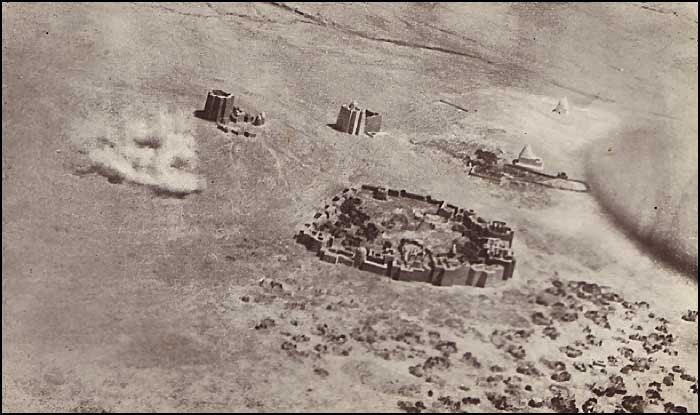 |
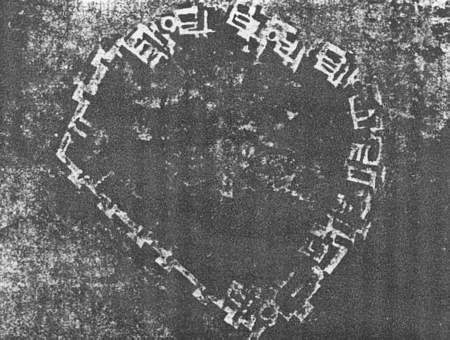 |
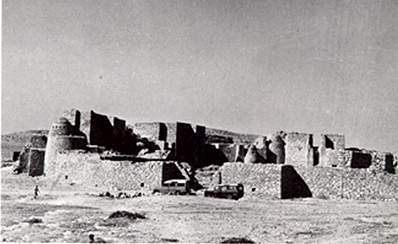 |
| Taleh being bombed by Force Z | Taleh aerial view | Taleh |
The
aircraft provided valuable reconnaissance photographs, mapping data and
information on the Dervish forces.
In addition they photographed their own operations giving information on the
effectiveness of the bombing.
Native huts
It is also worth noting that two
days after Taleh fell the Governor flew there so that he could thank the
friendlies for their excellent work.
He was also able to talk with them on the spot about local administrative
and political matters of importance.
This also had a deep psychological effect on the tribal leaders.